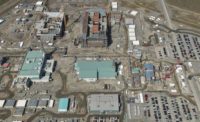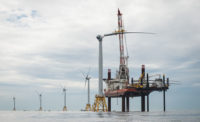The government’s two-decade effort to transform 56 million gallons of long-stored radioactive waste into inert glass for disposal at the federal Hanford nuclear waste cleanup site in Washington state moved closer to reality this month.
Construction was completed on the 3,500-ft-long pipeline that will begin to move low-level waste streams from 177 underground tanks at the former plutonium production site to the $17-billion treatment plant, set to be commissioned this year before its state-mandated 2023 startup, the US Energy Dept. said Aug. 20.
DOE site manager Brian Vance termed the completion “a significant step” for the much-challenged waste vitrification program, which began in 2002.
The conveyance system that will move stored waste underground to one unit of the waste treatment plant is made up of a stainless steel primary pipe, similar to what is used elsewhere at Hanford, which is encased by a 6-in-dia. secondary pipe for redundancy protection, says a spokesperson for tank farm contractor Washington River Protection Solutions.
Moving to Startup
The “pipe-in-pipe” transfer line will carry waste from a double-shelled holding tank where it has been treated to remove radioactive cesium and solids, says DOE. Contractor workers installed the cesium removal system next to the tank farm earlier this year and are conducting readiness tests before treatment of low-level nuclear wastes in batches is set to start early next year.
That treatment will follow two key tests, according to Bechtel, buiider of the vitrification complex. One in October will determine impact from possible power loss, to be followed by a December heat-up of the first of the plant's two giant waste melters.
"We are over 90% complete, but the last 10% is going to be a climb," says Valerie McCain, Bechtel treatment plant project director, in moving the first treatment unit and 14 support facilities from construction through startup testing to commissioning. "It is very exciting each time we complete testing and it gets handed over to the plant management team," she says.
Technical issues have delayed and kept uncertain the completion status of other units at the plant that were set to separate tank waste into high level and low level volumes for separate treatment and disposal.
DOE announced earlier this year that it will award a combined contract for vitrification plant and tank farm operation, which will be for up to 10 years and valued at about $27 billion. A DOE spokesman declined comment on Aug. 26 on projected dates to issue its final request for proposals and make a contract award. The agency extended for two years, under a $725-million award, the WRPS tank farm contract that had been set to end on Oct. 1.
WRPS is a joint venture of Amentum, which AECOM spun off in early 2020 to private equity buyers, and Atkins, a unit of SNC-Lavalin Inc. Amentum also acquired federal contractor DynCorp International last November, creating what it described as a $6-billion firm.
To convert tank waste into vitrified glass, treatment plant melters will heat waste and glass-forming materials to 2,100° F. Once heated, the melter can't lose power for the duration of its life to prevent glass from hardening. "The melter one heat-up is ... really the point of no return," says Tom Fletcher, DOE federal project director for the waste treatment plant. "At that point, this plant remains hot 365 days a year, 24 hours a day. You can't turn off a melter."
The loss of power test will ensure that the plant workforce can demonstrate ability to respond to a need to restart required systems without impeding the melter, Fletcher says. "If we lose power, how does our team put the facility in a safe position and how do we bring it back from that condition?"
System Backups
Melter heat-up leads to the start of cold commissioning in February 2022, followed by testing of the second melter in April.
Cold commissioning will involve use of chemicals simulating wastes that will test more than 5,500 treatment procedures, Fletcher says.
Staggering the second melter was a "risk reduction" change made to the plan in the last two years. Fletcher says. Melters were designed by Duratek and fabricated by Petersen Inc., Ogden, Utah, with two others on site to replace the originals when they end their life.
The hot commissioning process planned for spring 2023 is the first entry of radioactive waste when the plant is turned over to operations.
"We have a lot of risk to manage for spring 2023 to happen," Fletcher says. “This is our top priority."
Hanford is a relic of World War II and Cold War nuclear weapons production spread across 580 sq miles of desert plateau from 1943 to 1987. Cleanup of plutonium and other wastes has been ongoing for more than three decades with project budget levels fluctuating over that time.
Under the Biden administration, funding has remained steady, and the House of Representatives has already voted to increase the budget for the waste project above what the administration requested, but that figure has yet to pass the Senate.





Post a comment to this article
Report Abusive Comment